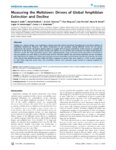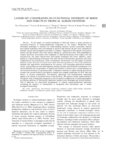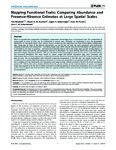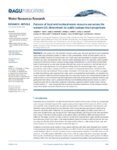|
|
Creator | Title | Description | Subject | Date |
| 1 |
 |
Dearing, Maria-Denise | [Dearing_Database_Pilot] | [Database deposited March 08, 2013, as part of a pilot project, eResearch Committee, University of Utah.] [This description should include information that explains the dataset in detail in a manner that would be useful to potential reuse. The contact information for the primary investigator should ... | [Creator keywords here.] | 2013-03-08 |
| 2 |
 |
Olivera, Baldomero M. | Novel venom peptides from the cone snail Conus pulicarius discovered through next-generation sequencing of its venom duct transcriptome | The venom peptides (i.e., conotoxins or conopeptides) that species in the genus Conus collectively produce are remarkably diverse, estimated to be around 50,000 to 140,000, but the pace of discovery and characterization of these peptides have been rather slow. To date, only a minor fraction have be... | | 2012 |
| 3 |
 |
Sekercioglu, Cagan | Measuring the meltdown: drivers of global amphibian extinction and decline | Habitat loss, climate change, over-exploitation, disease and other factors have been hypothesised in the global decline of amphibian biodiversity. However, the relative importance of and synergies among different drivers are still poorly understood. We present the largest global analysis of roughly ... | | 2008-01-01 |
| 4 |
 |
Olivera, Baldomero M. | Combined proteomic and transcriptomic interrogation of the venom gland of conus geographus uncovers novel components and functional compartmentalization | Cone snails are highly successful marine predators that use complex venoms to capture prey. At any given time, hundreds of toxins (conotoxins) are synthesized in the secretory epithelial cells of the venom gland, a long and convoluted organ that can measure 4 times the length of the snail's body. In... | | 2014-01-01 |
| 5 |
 |
Sekercioglu, Cagan | Causes and consequences of bird extinctions | Increased human domination of the planet has caused the declines and extinctions of countless species. Each species has not only intrinsic value, but ecological functions of organisms are also essential for the integrity of ecosystems that allow people to benefit from essential free ecosystem servic... | | 2003-01-01 |
| 6 |
 |
Potts, Wayne K.; Granger, Donald Lee | Major histocompatibility complex-dependent susceptibility to Cryptococcus neoformans in mice | To evaluate the role of major histocompatibility complex (MHC) genes in the resistance to Cryptococcus neoformans, we conducted infection experiments in MHC-congenic strains of mice. Significant MHC-dependent susceptibility differences were found among homozygotes and heterozygotes. This study is th... | MHC-congenic; Host resistance; Infection | 2003 |
| 7 |
 |
Ehleringer, James R. | Carbon isotope ratios in belowground carbon cycle processes | Analyses of carbon isotope ratios (δ13C) in soil organic matter (SOM) and soil respired CO2 provide insights into dynamics of the carbon cycle. δ13C analyses do not provide direct measures of soil CO2 efflux rates but are useful as a constraint in carbon cycle models. In many cases, δ13C analyses... | Below ground processes; Ecosystems; Carbon cycle; Carbon isotope ratio; Ecosystem processes; Global change; Soil organic carbon; Soil organic matter | 2000 |
| 8 |
 |
Coley, Phyllis D.; Kursar, Thomas A. | Food quality, competition, and parasitism influence feeding preference in a neotropical lepidopteran | We surveyed Lepidoptera found on 11 species of Inga (Fabaceae:Mimosoideae) co-existing on Barro Colorado Island, Panama, to evaluate factors influencing diet choice. Of the 47 species of caterpillars (747 individuals) recorded, each fed on a distinct set of Inga. In the field, 96% of the individuals... | Competition; Electivity; Gelechiid; Herbivore growth; Fabaceae; Inga; Leaf expansion; Leafing phenology; Lipidoptera; Panama; Parasitism; Plant quality | 2006 |
| 9 |
 |
Sekercioglu, Cagan | Keystone species in seed dispersal networks are mainly determined by dietary specialization | One central issue in Ecology ecology has been the definition and identification of keystone species, i.e., species that are relatively more important than others for maintaining the structure of a community. Several keystone species concepts have been proposed, and network theory has been pointed o... | | 2014-01-01 |
| 10 |
 |
Adler, Frederick R. | How virulent should a parasite be to its vector? | Vector-borne parasites are commonly predicted to be less virulent to the vector than to the definitive host as the parasite gains little by harming its main route of transmission. Here we assess the empirical evidence from systems in which insects are vectors for vertebrate, plant, and invertebrate ... | Parasite virulence; Hosts; Vector-borne parasite | 2003 |
| 11 |
 |
Sekercioglu, Cagan | Landscape constraints on functional diversity of birds and insects in tropical agroecosystems | In this paper, we analyze databases on bird and insects to assess patterns of functional diversity in human-dominated landscapes in the tropics. Perspective from developed landscapes is essential for understanding remnant natural ecosystems, because most species experience their surroundings at spat... | | 2008-01-01 |
| 12 |
 |
Thomas, Kirk R.; Capecchi, Mario R. | Maintenance of functional equivalence during paralogous Hox gene evolution. | Biological diversity is driven mainly by gene duplication followed by mutation and selection. This divergence in either regulatory or protein-coding sequences can result in quite different biological functions for even closely related genes. This concept is exemplified by the mammalian Hox gene comp... | Alleles; Animals; Cervical Vertebrae; Embryo; Genetic Complementation Test; Homeodomain Proteins; Homozygote; Mice | 2000-02-10 |
| 13 |
 |
Coley, Phyllis D. | On turning green into gold | Anthropogenic effects on the climate and biodiversity of our planet are among the most troubling and perhaps irreversible threats facing scientists, policymakers, and citizens. Yet many scientists are reluctant or unsure of how to apply their expertise in basic science to these pressing real-world p... | Bioprospecting; Drug discovery; Active compounds; Panama | 2008 |
| 14 |
 |
Sekercioglu, Cagan | Mapping functional traits: comparing bundance and presence-absence estimates at large spatial scales | Efforts to quantify the composition of biological communities increasingly focus on functional traits. The composition of communities in terms of traits can be summarized in several ways. Ecologists are beginning to map the geographic distribution of trait-based metrics from various sources of data,... | | 2012-01-01 |
| 15 |
 |
Potts, Wayne K. | Infection-dependent phenotypes in MHC-congenic mice are not due to MHC: can we trust congenic animals? | Congenic strains of mice are assumed to differ only at a single gene or region of the genome. These mice have great importance in evaluating the function of genes. However, their utility depends on the maintenance of this true congenic nature. Although, accumulating evidence suggests that congenic ... | Strains; Mutations; Pathogen | 2004 |
| 16 |
 |
Ehleringer, James R. | Patterns of local and nonlocal water resource use across the western U.S. determined via stable isotope intercomparisons | In the western U.S., the mismatch between public water demands and natural water availability necessitates large interbasin transfers of water as well as groundwater mining of fossil aquifers. Here we identify probable situations of nonlocal water use in both space and time based on isotopic compari... | | 2014-01-01 |
| 17 |
 |
Coley, Phyllis D. | Coibanoles, a new class of meroterpeniods produced by pycnoporus sanguineus | Three new terpenoids of mixed biosynthetic origin were isolated from the culture filtrate of the endophytic fungus Pycnoporus sanguineus. Their structures were determined by extensive spectroscopic analyses. We have named these tricyclic and tetracyclic metabolites ?coibanoles A?C? in reference to... | | 2012 |
| 18 |
 |
Ehleringer, James R. | ENSO effects on primary productivity in Southern Atacama desert | In the winter-rain southern Atacama Desert of the Coquimbo Region of Chile, El Niño - Southern Oscillation (ENSO) events modulate primary productivity. In this region, there are important changes in water availability between La Niña (dry) and El Niño (rainy) years. Using interannual comparison... | El Niño; Atacama Desert; Terrestrial ecosystems; Plant productivity | 2006 |
| 19 |
 |
Coley, Phyllis D. | New cytotoxic cinnamic acid derivatives from leaves of Bonamia trichantha | Bioassay-guided fractionation of the methanolic extract of the young leaves of Bonamia trichantha led to the isolation of four new cinnamic acid derivatives trichanthins A-D (l-4).Their structures were established by spectroscopic methods. All compounds were tested in cytotoxic assays against the MC... | Bonamia trichantha; Cinnamic acid; Caffeic acid ester; p-Coumaric acid ester: Farnesol; Z-(l l)-hexadecen-l-ol; Cytotoxicity | 2006 |
| 20 |
 |
Olivera, Baldomero M.; Ireland, Chris M. | NMR structures of conotoxins | This review discusses the methodology, structural details, and biological implications regarding NMR structures of conotoxins. NMR and molecular modeling techniques have improved to the point that three-dimensional structures of conotoxins can now be determined with a significant degree of confiden... | Conotoxins | 1996 |
| 21 |
 |
Capecchi, Mario R. | Sepp1UF forms are N-terminal selenoprotein P truncations that have peroxidase activity when coupled with thioredoxin reductase-1 | Mouse selenoprotein P (Sepp1) consists of an N-terminal domain (residues 1-239) that contains 1 selenocysteine (U) as residue 40 in a proposed redox-active motif (-UYLC-) and a Cterminal domain (residues 240-361) that contains 9 selenocysteines. Sepp1 transports selenium from the liver to other tiss... | | 2014-01-01 |
| 22 |
 |
Beckerle, Mary C.; Hoffman, Laura M. | Targeted disruption of the murine zyxin gene | Zyxin is an evolutionarily conserved protein that is concentrated at sites of cell adhesion, where it associates with members of the Enabled (Ena)/vasodilator-stimulated phosphoprotein (VASP) family of cytoskeletal regulators and is postulated to play a role in cytoskeletal dynamics and signaling. | Zyxin | 2003 |
| 23 |
 |
Coley, Phyllis D. | Tritrophic interactions in tropical versus temperate communities | The latitudinal gradient in diversity is one of the oldest (e.g., Wallace, 1878) and most obvious trends in ecology, and a wealth of literature is devoted to understanding both the causes and consequences of this gradient (Dobzhansky, 1950; also reviewed by Rohde, 1992). Given the enormous latitudi... | Tritrophic interactions; Trophic cascades; Herbivory; Tropical communities; Temperate communities | 2002 |
| 24 |
 |
Coley, Phyllis D. | Chemical and bioactive natural products from microthyriaceae sp., an endophytic fungus from a tropical grass | In screening for natural products with antiparasitic activity, an endophytic fungus, strain F2611, isolated from above-ground tissue of the tropical grass Paspalum conjugatum (Poaceae) in Panama, was chosen for bioactive principle elucidation. Cultivation on malt extract agar (MEA) followed by bioas... | | 2014-01-01 |
| 25 |
 |
Gesteland, Raymond F.; Atkins, John F. | Evolutionary specialization of recoding: frameshifting in the expression of S. cerevisiae antizyme mRNA is via an atypical antizyme shift site but is still +1 | An autoregulatory translational shift to the +1 frame is required for the expression of ornithine decarboxylase antizyme from fungi to mammals. In most eukaryotes, including all vertebrates and a majority of the studied fungi/yeast, the site on antizyme mRNA where the shift occurs is UCC-UGA. The me... | Antizyme; ODC; Polyamines; Frameshifting | 2006 |

























